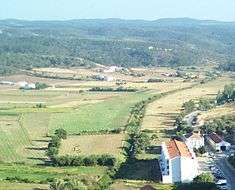Ponte de Aljezur
| Bridge of Aljezur Ponte de Aljezur | |
|---|---|
| Coordinates | 37°19′00″N 8°48′12″W / 37.316655°N 8.803261°WCoordinates: 37°19′00″N 8°48′12″W / 37.316655°N 8.803261°W |
| Carries | vehicles, pedestrians |
| Crosses | Ribeira de Aljezur |
| Locale |
|
| Official name | Ponte de Aljezur |
| Heritage status | Included in the Nature Park of Southwest Alentejo and St. Vincent Coast; partially included in the sector plan of Natura 2000 Network (Habitats 3290 and 6420) |
| Followed by | Medieval bridge |
| Characteristics | |
| Material | Structure in plastered and whitewashed masonry, arched staves, pillars and talhamares in stone or masonry; guards in cement grilling; asphalt pavement on roadway, cobblestones and industrial tile on pedestrian walkways. |
| Total length | 39 metres (128 ft) |
| Width | 6 metres (20 ft) |
| History | |
| Designer | unknown |
| Construction begin | Middle Ages |
| Opened | 18th century |
| Collapsed | 4 March 1947 |
| Statistics | |
| Daily traffic | Aljezur, EN120/Rua 25 de Abril; Largo do Mercado; Largo da Liberdade |
The Ponte de Aljezur (Bridge of Aljezur), is a structure located over the Ribeira de Aljezur, in the civil parish of Aljezur, municipality of Aljezur, in the Portuguese district of Faro.
History
The original bridge, which was situated a few meters from the actual pedonal viaduct, was constructed sometime in the Medieval Age.[1]
It was reconstructed between the 17th and 18th century, with its original wood was used in the fabrication of utensils and implements for agriculture and fishing.[1]
On 4 March 1947, the bridge was damaged by a flood that destroyed the original medieval bridge: it was re-constructed sometime in the second half of the 20th century.[1] João Carlos Castelo Branco Soares Albergaria, as part of the impact assessment study for the construction of EN120 highway crossing through Aljezur, examined the bridge in 2011 for vestiges of the old port.[1]
Geography

.jpg)
The bridge is situated over the Ribeira de Aljezur, in an area located at the confluence of the Ribeira de Alfambras and Ribeira da Cerca, at the eastern lowlands of Aljezur.[1] It is obligatory northern passage from the Algarve along the EN120 and, similarly, the principal access to the old village (including market).[1]
The silted margins of the river, in an area 15 metres (49 ft) from the bridge, are important habitats for waterfowl and species. The presence of European alder (Alnus glutinosa), Poplar (Populus), Willow (Salix) and Reed bed provides a habitat for various species of Spanish pond turtle (Mauremys leprosa), Viperine water snake (Natrix maura), Mallards (Anas platyrhynchos), Muscovy ducks (Cairina moschata), Greylag goose (Anser anser), Grey wagtail (Motacilla cinerea) and the Common nightingale (Luscinia megarhynchos).[1] Along the banks are various aromatic plants, such as Rosemary, Lavander and Mint.[1] To the east stretches a fertile floodplain, used for cultivating sweet potato and corn, and as pasturelands for dairy cattle. Downstream are vestiges of the ancient fluvial port with mooring posts, and a cisterns that was situated near the (now disappeared) inn and tollhouse.[1] Tp the west of the bridge, near the entrance to the south, is the old village grocery, while to the east (and few meters away) is the municipal market.[1]
Architecture
The mixed-use bridge is 39 metres (128 ft) long by 8 metres (26 ft) wide, oriented east to west. It is a three arch structure, of equal dimensions, over two rectangular pillars linked and leveled to the roadway.[1]
The bridge is constructed of masonry, plastered and whitewashed with exposed stone along its arches, while the guards with pilasters, painted grey.[1] The asphalt roadway is lined by pedestrian walkways in Portuguese pavement stone, and industrial tile. To the extreme west the road curves to the north, bypassing a small courtyard and palm tree, with an identical guardrail that delimit the left bank of the river.[1]
References
Notes
Sources
- Bernardes, João Pedro (2006), "Existem Pontes Romanas no Algarve?", in Pereira, Angelina, Actas das I Jornadas as vias do Algarve da Época Romana à Actualidade, São Brás de Alportel, Algarve: Câmara Municipal de São Brás de Alportel/CCDR, pp. 14–19
- Câmara Municipal, ed. (1 July 2015), Roteiro do Circuito Histórico-Cultural de Aljezur (PDF), Câmara Municipal de Aljezur